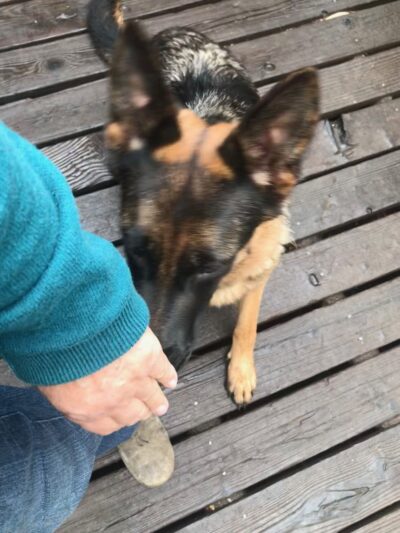By Fran Jewell

The best time to start leash training is the day you bring your puppy home. Many have thought that you cannot begin leash training until a puppy is six months old. By then, most puppies have learned that if they pull, they get more. So stop it at the start. Prevention is always our best tool.
When I have a litter of pups, I start training as young as four WEEKS old. At that age it is incredibly easy to use almost all positive reinforcement. It becomes much harder to train once the puppy has gotten inadvertent positive reinforcement for behaviors we don’t like and now they have become habitual behaviors.
I would say leash training is one of the most difficult things to teach dogs. The earlier they learn it, the easier it is. For leash training, there are many, many different ways to train and it will depend on your puppy and your abilities. As an example, I like to train larger breed puppies because bending over to reach a tiny puppy is very hard for me. So, sometimes, I will choose a different method, or move very quickly to train, so I spend less time bending over.
Some people resort to holding the leash very tightly so the dog must stay next to them. This, however, inadvertently teaches the dog that being next to their person is uncomfortable and very unpleasant.
Of course, there are some dogs that are naturally respectful of the leash and need very little training. It does happen, but it may take some time to find that dog. I would guess as many as 10 percent of the dogs out there will naturally walk next to you without pulling on a leash.
This method can be used with older dogs, too, but may take longer and depends on your commitment and consistency.
Here are some guidelines:
- Find a safe, contained place without other dogs. A fenced-in yard or inside your house are good ideas. This way you can work with the dog off-leash without the chance of your dog getting hurt.
- Have a hungry puppy or dog.
- Find a treat that your dog adores that is not too small.
- Stuff your left pocket or a treat bag on your left with the treats. Use the left because that is the traditional side on which to teach the command “heel.” If you prefer the right, that is okay; however, you must choose one side to avoid too much confusion for your pup.
- Pick a marker word or noise. One person I know uses the word “ding.” I use the word “yes” because it means exactly what it says. Sometimes I use a clicker as a noise marker.
- Pair your marker, word or noise with food. This is classical conditioning. Yes equals treat. Practice about five times.
- Now walk holding your treat between your fingers with your hand facing backward. Slide your hand down your left pant leg to lure your puppy with you.
- When your puppy comes to your left side to sniff or take the treat, say “yes!” or “ding!” or use your clicker. Then give the treat.
- Don’t feed your puppy if she comes around to the front of you. The reason is simply so you don’t have to step through her to start going again.
- If she is doing this easily, try to keep walking while giving her the food. If you keep your hand facing backward, chances are she will learn not to forge ahead of you or walk in front of your steps.
- Do only a few steps at a time, then stop and reward your puppy for sitting. Don’t try to take long walks doing this. Work up to longer walks over a period of time.
- Eventually, add steps between treats so you are giving fewer and fewer treats while your puppy is still able to perform the behavior.
When a puppy learns from the start that walking next to you is a fun thing, it can imprint a long-lasting, lifetime behavior.
Fran Jewell is an Idaho Press Club award-winning columnist, IAABC-certified dog behavior consultant, NADOI-certified instructor #1096 and the owner of Positive Puppy Dog Training, LLC, in Sun Valley. For more information, visit www.positivepuppy.com or call (208) 578-1565.


